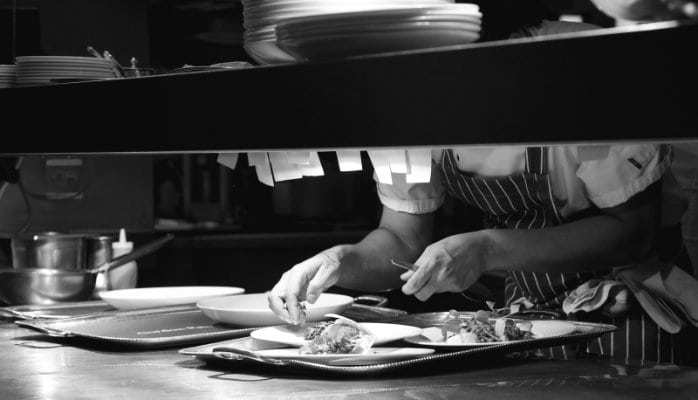For any food-based business, the communications between staff from kitchen to table should be seamless. One area where newcomers may come unstuck is commercial kitchen terminology. So we’ve created a list of terms you might hear in and around a commercial kitchen and explain what they mean in layman’s terms.
Background to commercial kitchen terminology
Most of the terminology you’ll hear in commercial kitchens has its roots in French cuisine. However, many terms are short-form kitchen slang that have become part of the vernacular that is unique to the commercial kitchen.
Mise en place
Pronounced “meez ahn plas” (or shortened to just “meez”), this is a French term for “everything in its place”. Hours before service is due to commence, the cooks and/or kitchen staff will set up a station and prepare all of the ingredients needed to assemble the dishes on the menu.
Chit
A chit is the printed ticket showing customers’ orders that are received by the kitchen.
The line
The line refers to the kitchen space where the cooking is done. It is often set up in a line for ease of workflow. To be “on the line” means you are a “line cook” – an essential part of any successful kitchen.
Fire
This is a command to start cooking a dish that has been ordered. Typically the server watches the tables and anticipates when they are ready for the next course. The chef or expeditor in charge of the pass will tell the cooks what dishes to fire. Each cook must then ensure the different components of a dish are ready at the same time.
5 Out / 3 Out
Coordination is essential in any commercial kitchen, especially when multiple cooks are responsible for different components, garnishes, and dishes. For example, when a cook yells out “5 out on the sirloin” they are letting the other cooks know they will be ready to plate in 5 minutes. This should result in all components of the dish being ready for plating at the same time.
12-top / 4-top / Deuce
12-top refers to a table of 12 diners, 4-top is a table of 4, and Deuce means two diners.
On the fly
“On the fly” is a term used when the order has been forgotten and the customer requires their order sooner rather than later. This means the order must be cooked now, or “on the fly”.
Stretch it
“Stretch it” means that an element of a dish is running low so the kitchen staff must make it last for the rest of the service. The easiest way to “stretch” an element of a dish is to serve a smaller portion of it. For example, serving less sauce with a dessert.
The pass
When dishes have been plated and are ready to serve they are placed on “the pass”. The chef or cook who runs the pass is responsible for announcing orders, watching the order ticket, monitoring the speed of orders, and making sure each dish is presented perfectly before it goes out.
Pick up
The “pick up” happens when the chef announces “pick up table #“. This lets the waitstaff know the dishes are ready to be served to customers at a certain table.
All day
During a busy service, you may hear the chef or expeditor (person reading off the orders) use the term “all day” (eg. “2 Scotch fillets medium rare, 2 linguine, and 3 schnitzels, all day“). This is a quick way to remind the cooks of the total amount of dishes for a specific “pick up“.
86’d
This is a term used by kitchen staff to inform wait staff that the kitchen has run out of a certain dish.
In the weeds / weeded
“In the weeds” or “weeded” is used when service is so busy that the cooks are inundated with orders and are either about to or are already falling behind.
Service starts here
Members of our team have been working in the hospitality industry for more than 20 years. We can help you choose the right hospitality supplies.
Please feel free to call us on (02) 9052 9111

